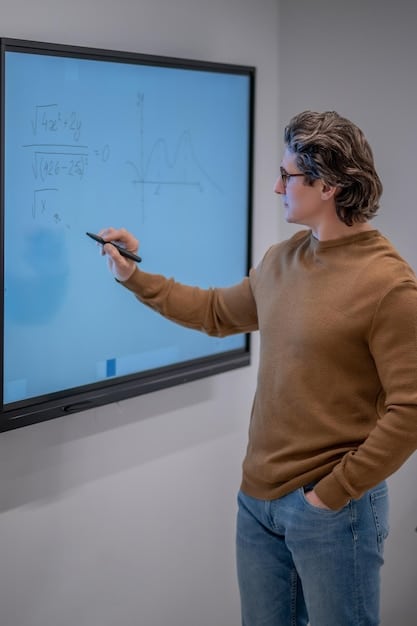Updated Teacher Certification & Professional Development Requirements in the US for 2025

The updated requirements for teacher certification and professional development in the US for 2025 focus on enhanced pedagogical skills, technology integration, cultural competency, and social-emotional learning to meet the evolving needs of diverse student populations and prepare educators for future challenges.
Are you ready for the 2025 school year? The educational landscape is constantly evolving, and with it, the requirements for teacher certification and professional development. Understanding the updated requirements for teacher certification and professional development in the US for 2025 is crucial for both aspiring and current educators to ensure they meet the standards and continue to provide high-quality instruction to students.
Understanding the Evolving Landscape of Teacher Certification
Teacher certification is the process by which individuals are licensed to teach in public schools. These certifications, issued by state education agencies, confirm that educators have met specific requirements and are equipped to instruct students effectively. However, these standards are not static; they evolve to reflect the changing needs of both students and the educational system.
Why Teacher Certification Requirements Change
Several factors drive the need for updated teacher certification requirements. As research in pedagogy and educational psychology advances, new teaching methods and strategies become available. Additionally, societal changes, such as increased cultural diversity and technological advancements, necessitate that teachers possess a broader range of competencies.
- Advancements in Pedagogy: New teaching methodologies emerge, requiring educators to update their skills.
- Societal Changes: Increased diversity and technological advances reshape the classroom environment.
- Accountability Measures: Federal and state mandates often lead to changes in certification standards.
Consequently, understanding these evolving requirements is essential for educators who aim to remain effective and compliant within their profession. Keeping abreast of these changes not only ensures compliance but also enhances their ability to meet the diverse needs of their students.

Key Changes in Initial Teacher Certification Requirements
For those aspiring to become teachers, the initial certification process is a critical first step. Recent updates across various states reflect a heightened emphasis on practical experience, content knowledge, and pedagogical skills. It’s essential for aspiring educators to be aware of these changes to adequately prepare for their careers.
Increased Emphasis on Practical Experience
Many states now require teacher candidates to complete more extensive field experiences or internships. This practical, hands-on experience is designed to provide candidates with real-world insights into classroom management, lesson planning, and student interaction.
Strengthened Content Knowledge Assessments
Prospective teachers must demonstrate a deep understanding of the subject matter they intend to teach. States are reinforcing content knowledge assessments by requiring higher passing scores or implementing more rigorous testing formats.
- Praxis Exams: Many states use Praxis exams to assess content knowledge.
- Performance-Based Assessments: Some states are incorporating performance-based assessments, such as edTPA, to evaluate teaching skills.
- Specific Coursework Requirements: Certain states mandate specific coursework in areas like special education or English language learning.
In conclusion, these changes in initial teacher certification requirements emphasize a more comprehensive preparation process that ensures new teachers are well-equipped to meet the challenges of modern classrooms.
Evolving Requirements for Professional Development
Professional development is critical for maintaining and enhancing teaching skills throughout a career. The updated requirements for professional development in the US reflect a shift towards more targeted, continuous, and evidence-based learning opportunities. Educators need to be aware of these changes to stay current and effective.
The changing landscape necessitates ongoing efforts to improve teaching practices:
Focus on Evidence-Based Practices
Professional development programs are increasingly focused on evidence-based practices that have been proven to improve student outcomes. This includes training in areas such as differentiated instruction, formative assessment, and classroom management techniques.
Integration of Technology
With the rise of digital learning tools, professional development is incorporating technology integration training. Teachers are learning how to use technology to enhance instruction, personalize learning, and engage students more effectively.

- Online Professional Development: Many states are offering online courses and webinars to make professional development more accessible.
- Mentorship Programs: Mentorship programs provide new teachers with guidance and support from experienced educators.
- Collaborative Learning: Collaborative learning communities enable teachers to share best practices and learn from each other.
Ultimately, evolving professional development requirements aim to ensure that educators are continuously growing and adapting to the ever-changing needs of their students.
The Role of Technology in Updated Certification Standards
Technology plays an ever-increasing role in education, driving significant changes in teacher certification and professional development standards. Integrating technology effectively into teaching practices is no longer optional but a core competency. The updated standards emphasize the need for teachers to be proficient in leveraging digital tools and resources to enhance instruction and student learning.
Teachers are now expected to:
Demonstrate Proficiency in Digital Literacy
Teachers must exhibit a high level of digital literacy, encompassing skills such as using educational software, creating digital content, managing online learning platforms, and protecting student data. This proficiency enables them to effectively integrate technology into their instructional strategies.
Utilize Technology for Personalized Learning
The standards emphasize the use of technology to personalize learning experiences for students. Teachers are encouraged to use data analytics and adaptive learning tools to identify individual student needs and tailor instruction accordingly. The goal is to provide each student with a customized learning path that maximizes their potential.
To ensure teachers are equipped to meet these standards, professional development programs now include:
- Training on Specific Digital Tools: Workshops and courses that provide hands-on training on using educational software, learning management systems, and interactive whiteboards.
- Best Practices for Online Teaching: Guidance on designing engaging online lessons, facilitating virtual interactions, and assessing student learning in a digital environment.
- Integration of Digital Resources: Strategies for incorporating digital resources, such as videos, simulations, and virtual field trips, into classroom instruction.
Addressing Cultural Competency and Diversity in Education
Cultural competency and diversity are increasingly important aspects of teacher certification and professional development in the US. As classrooms become more diverse, educators must be equipped with the skills and knowledge to create inclusive and equitable learning environments. The updated certification standards place a strong emphasis on preparing teachers to address the diverse needs of their students effectively.
Understanding Cultural Diversity
Teachers need to develop a deep understanding of cultural diversity, including the values, beliefs, and backgrounds of their students. This understanding enables them to create culturally responsive lessons and build strong relationships with students from diverse backgrounds.
Promoting Inclusive Classroom Environments
Creating inclusive classroom environments is essential for ensuring that all students feel valued and respected. Teachers are expected to use inclusive teaching strategies, such as incorporating diverse perspectives into the curriculum and addressing issues of bias and discrimination.
Professional Development in Cultural Competency
Professional development programs now include:
- Training on Cultural Sensitivity: Workshops that help teachers develop cultural sensitivity and awareness.
- Strategies for Addressing Bias: Guidance on recognizing and addressing implicit biases in the classroom.
- Culturally Responsive Teaching Methods: Training on using culturally responsive teaching methods to engage diverse learners.
Implementation and Support for New Teachers
Effective implementation and adequate support are crucial for new teachers as they navigate the complexities of the profession, especially with the updated certification standards. States and districts are focusing on comprehensive induction programs, mentorship, and ongoing professional development to assist new educators in their first years of teaching. These initiatives aim to reduce teacher turnover and improve overall teaching quality.
Key components of implementation and support include:
Comprehensive Induction Programs
Induction programs provide structured support for new teachers, including mentoring, professional development, and peer collaboration. These programs help new teachers adjust to the demands of the classroom and develop effective teaching practices.
Mentorship Programs
Mentorship programs pair new teachers with experienced educators who provide guidance and support. Mentors offer advice on classroom management, lesson planning, and student assessment, helping new teachers grow and thrive in their roles.
Ongoing Professional Development
To keep new teachers abreast of the latest educational trends, districts are offering ongoing professional development opportunities. These programs cover topics such as:
- Classroom Management: Effective strategies for managing student behavior and creating a positive learning environment.
- Differentiated Instruction: Techniques for tailoring instruction to meet the diverse needs of students.
- Technology Integration: Best practices for using technology to enhance teaching and learning.
| Key Point | Brief Description |
|---|---|
| 📝 Enhanced Pedagogy | Focus on evidence-based teaching practices. |
| 💻 Technology Integration | Utilizing digital tools for personalized learning. |
| 🌍 Cultural Competency | Creating inclusive classrooms for diverse students. |
| 🤝 New Teacher Support | Comprehensive induction and mentorship programs. |
[Frequently Asked Questions]
▼
The key areas include enhanced pedagogical skills, technology integration, cultural competency, and support for diverse learners. Professional development emphasizes evidence-based practices and personalized learning.
▼
Technology integration is now a core competency, requiring teachers to demonstrate proficiency in using digital tools and resources to enhance instruction and personalize learning experiences.
▼
Cultural competency ensures teachers can create inclusive and equitable learning environments by understanding and addressing the diverse needs and backgrounds of their students.
▼
Support includes comprehensive induction programs, mentorship from experienced educators, and ongoing professional development focused on effective teaching practices and classroom management.
▼
Teachers can stay informed by regularly checking state education agency websites, attending professional development sessions, and participating in educational communities and networks.
Conclusion
Staying informed about the updated requirements for teacher certification and professional development is paramount for educators in the US. By focusing on enhanced pedagogy, technology integration, cultural competency, and robust support systems, the educational system aims to equip teachers with the tools and knowledge necessary to foster student success in an ever-evolving world.





